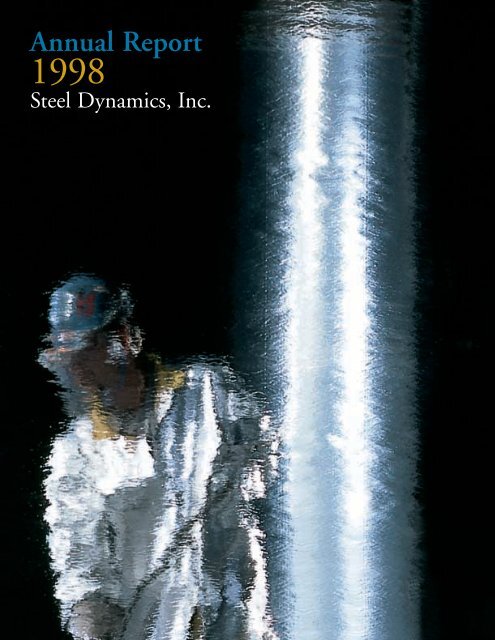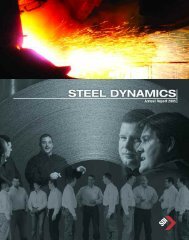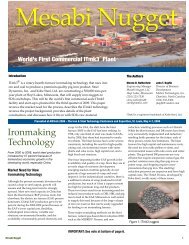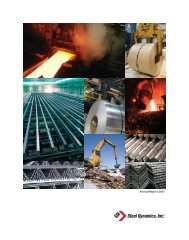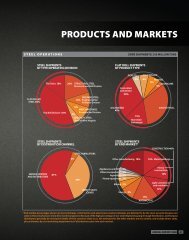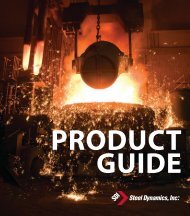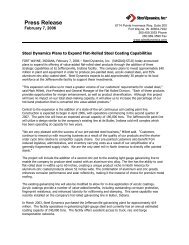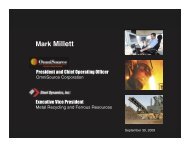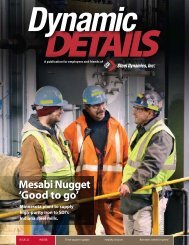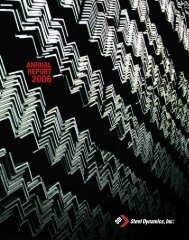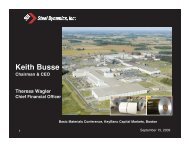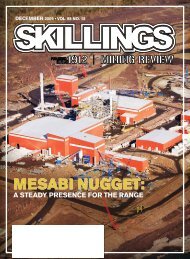Annual Report - Steel Dynamics, Inc.
Annual Report - Steel Dynamics, Inc.
Annual Report - Steel Dynamics, Inc.
- No tags were found...
You also want an ePaper? Increase the reach of your titles
YUMPU automatically turns print PDFs into web optimized ePapers that Google loves.
<strong>Annual</strong> <strong>Report</strong>1998<strong>Steel</strong> <strong>Dynamics</strong>, <strong>Inc</strong>.
© Copyright 1999 <strong>Steel</strong> <strong>Dynamics</strong>, <strong>Inc</strong>.On the cover, Jeff Vinson’s image is reflected innewly coated steel on SDI’s hot-rolled, hot-dipgalvanizing line 1. At left is a fuller view ofVinson at work, skimming impurities from thesurface of the molten zinc pot—“drossing thepot,” as it’s called. In the photo on the oppositepage are the “brightener bars” which, in moltenstate, aid in the adherence of the various coatingsSDI applies to steel in its cold mill.
ContentsA Letter to Shareholders 2A Message From the Company Leadership 4The Faces and Voices of SDI 6Financial Information 18
A MESSAGE FROM THE PRESIDENT AND CEOTo Our Valued ShareholdersFor <strong>Steel</strong> <strong>Dynamics</strong>, 1998 was a year of significantcompany accomplishments, even though as an industry thesteel business was about to suffer one of its worst economicperiods in decades.While the soft markets experienced by the flat-rolled steelindustry during the first half of 1998 gave way to the virtualcollapse of the steel markets during the third and fourthquarters, amidst an avalanche of unfairly traded imports, SDIsteadfastly pursued a twin objective: attain the lowest operatingcosts and highest operating profits per ton in the steel industryconsistent with the company’s high standards of quality and<strong>Steel</strong>–in absoluteterms, let alone onan inflation-adjustedbasis–may be one ofthe best commoditybuys on earth.service, and continue to implement the company’s growthstrategy. In the final analysis, the ability to achieve these goals inthe midst of such negative market conditions is the acid test of acompany’s character, and we believe that SDI more than metthe test.Not surprisingly, the devastating conditions in thedomestic and international steel markets did in fact have anegative impact on SDI’s financial results, but the impact wasconsiderably less severe for SDI than for most other companiesin the steel industry, many of which are awash in red ink andsome of which even sought bankruptcy protection. In contrast,SDI achieved one of the highest operating profits ($50 perton) in the steel industry on shipments of 1,414,950 tons, anincrease in volume of 211,703 tons or 18%. Our net sales forthe year were $515 million versus $420 million in 1997, anincrease of 23%. Pretax income in 1998 was $52.6 millionversus $59.4 million in 1997. Our net income of $31.7million in 1998 was down from $43.9 million in 1997, duemainly to SDI’s having reached a full statutory effective tax ratein 1998. In 1997, SDI realized the last of its tax benefits fromthe loss carryforwards resulting from its original start-up.During 1998, SDI was involved with four major startups.Successful start-ups are positive events, for they eithersignify a project’s fruition or, perhaps, the launching of anew one. In the short term, though, they are a drag onearnings, but we are building your company and that is partof the territory.Throughout 1998, SDI continued to successfullystart up and commission its new cold mill, andalthough only able to realize a partial year’s benefitfrom the full integration of this world-class facility,we are very pleased to report that all units are nowoperating at near capacity.In late June, our new meltshop, second caster, andsecond tunnel furnace began operations. Like the coldmill, this new facility was also only able to realize apartial year’s production benefit. In addition, we werehampered by an unexpected electrical energy crisisduring the summer, resulting in an unplannedreduction in volume. Presently, however, our newmeltshop facilities are also operating at close to fullcapacity. We were also able to successfully modify our electricalservice agreement with American Electric Power to establish afixed electrical rate for our general service and to further limitthe number of hours and the circumstances under which AEPwill be allowed to interrupt SDI’s electrical service.Our Iron <strong>Dynamics</strong> (IDI) scrap substitute start-up wasdelayed from an anticipated December 1998 launch to Marchof 1999 for a variety of reasons, ranging from supplier delaysto our decision to make certain field modifications to IDI’sdeveloping proprietary technology. We continue to believethat this technology will embody the lowest capital cost perannual metric tonne of capacity and will yield the bestoperating results of any virgin ironmaking technology knowntoday. During January and February, we enjoyed early success2
in operating IDI’s new rotary hearth furnace to produce“DRI” (direct reduced iron) with “metallization” rates(percentages of pure iron) that we believe will give usexcellent results when combined with the second stage of theIDI process, converting the DRI into liquid pig iron in asubmerged arc furnace. On March 24, the submerged arcfurnace successfully produced its first heat of liquid pig iron.Last but not least, we anticipate that core constructionwork will commence in May on our new world-classstructural steelmaking facility that will be built on ourgreenfield site in Whitley County, Indiana. Preliminary sitework has been ongoing for some time, while awaiting thegovernment’s issuance for public comment of the new plant’sair permit. That having now occurred, we are anxious to getstarted and to make up for some of the lost time. All majorequipment has been ordered and will be arriving throughout1999. We anticipate a mid-2000 completion and start-up.During 1998 and early 1999, SDI achieved certainsignificant milestones which will bode well for our future.Our operating teams at Butler produced 7,000 tons of hotrolledbands in a single day, and are now producing hot-rolledsteel for 0.33 man-hours per ton. Our new cold mill in Butlerhas run at an annualized rate of 1.2 million tons, and ourcoating lines have achieved a production rate of 30,000 tonsper month. Our cold mill employees have achieved a laborrate of 0.35 man hours per ton. Collectively, this amounts toonly 2/3 of a man-hour per ton for finished products, mostlikely the best in the world, with still more to be achieved.SDI’s Butler employees helped the company earnISO-9002 certification, and employees in the cold millcontributed to that operation’s being recommended forQS-9000 certification, which will make SDI eligible toprovide quality products to the critical automotive andappliance communities. In early 1999, General Motorsannounced that it would pursue a business relationship withSDI, making our company the first mini-mill to be directlyincluded in that company’s elite cadre of suppliers. Inaddition, Daimler Chrysler informed SDI that the Heidtman<strong>Steel</strong>/<strong>Steel</strong> <strong>Dynamics</strong> team was one of its top-rated suppliersin 1998, a significant accomplishment for our company,which has been producing steel for only three years.I must, however, save the most important accolades forlast. In the end, hot mills and cold mills do not make steel.People make steel. New mills and new ironmaking facilitiesdo not just simply get built. They are inspired, designed,guided, superintended, fretted over, and invested with loadsof TLC by people, and, most importantly, by people like ouremployees, our most valuable assets, who are by far the best inthe world at what they do.And what about our valued customers and suppliers, whohave stood by us during these difficult times? They, too, arethe best in the world. Quality seeks quality. Theircontributions have helped make a difference in a marketpricing environment that we have not seen since the 1950s.In some ways, this speaks volumes about the resiliency of thisindustry. <strong>Steel</strong>—in absolute terms, let alone on an inflationadjustedbasis—may be one of the best commodity buyson earth.Our employees, our mostvaluable assets, are by farthe best in the world atwhat they do.Overall, I do believe that, in the first quarter of 1999, wewill have seen the bottom of the steel market and the bottomof SDI’s financial results. The economy is in excellent shape,and with dumped imports potentially abating—broughtabout in part as a result of successful trade cases brought bySDI and other steel industry players in September—weshould begin to see considerably improved earnings in 1999.If that occurs, and we trust it will, our growth plans of 1996,1997, and 1998 should begin to significantly contribute toour earnings.And I remain confident that the best employees in theindustry will continue to overachieve and establish newindustry milestones.Sincerely,Keith BussePresident and CEO3
A MESSAGE FROM THE MANAGEMENT TEAMIn Praise of 591 Extraordinary IndividualsWhen <strong>Steel</strong> <strong>Dynamics</strong> was founded, in 1993,management made a commitment: the companywould ask all employees to take an active role in the company,maintaining high standards of quality and keeping costs as lowas possible.This is not the way most steel-making companies function.SDI envisioned a grassroots management effort—withcritical decisions made by those closest to actual production,and with employee ownership fostered by participation instock-option and profit-sharing programs.“For SDI to haveperformed in a superiorway during this tryingtime is a tribute to thecompany’s employees. Ina normalized market,with this team of people,we can be extraordinarilysuccessful.”Some observers scoff at the notion that the folks who makethe steel should be encouraged to take leadership in thecompany, that they could actually be the primary energy of theorganization.“Our success is manifest from having a group of peoplewith no preconceived ideas—individuals relatively new to theindustry, unburdened by tradition—not knowing that it can’tbe done!” says Mark Millett, vice president and generalmanager of the Butler facility, a metallurgist and one of thepioneers of thin-slab steel casting.SDI has the finest steel-making equipment in the world.Day and night, weekday and weekend, that machinery is inmotion, producing SDI’s high-quality product. But goodequipment alone doesn’t make a company productive. Peopledo. And, as Keith Busse points out, SDI has the finest groupof employees in the industry. Some are veterans, othersnewcomers to the business. All have demonstrated theircommitment to ensuring customer satisfaction by producingproducts that meet global quality standards.“SDI shareholders are concerned about value,” says TracyShellabarger, vice president and chief financial officer. “So areour employees, who think like investors because they areinvestors. All employees are shareholders in the company. Onthe screen of every SDI computer terminal is an icon thatreads ‘Stock Price.’ From the casting deck in the hot mill, tothe pickle line in the cold mill, to the receptionist’s desk at ourheadquarters in Fort Wayne, hundreds of SDI employees clickon that icon several times a day. They want to know how theirinvestment in the company is faring in the marketplace.”As it has moved forward on two fronts—actualproduction and building new capacity—SDI has reliedheavily on employees’ bringing to the workplace a largemeasure of the entrepreneurial energy that underlies all oftoday’s successful business ventures. This has paid off for thecompany, its employees, and its stockholders.“The expansive growth at Butler, while operating theexisting facilities, has been stressful for everyone—employeesand their families,” says Mark Millett. “But we’re coming tothe end of that phase with the successful completion of theseprojects. Now watch out: the talents of these individuals havebeen unleashed and focused on taking world-class standardsof productivity, quality, and cost structure to new levels.“The various expansions, meanwhile, have createdwell-earned opportunities for our people—individuals withexperience moving into management positions, creatingother opportunities down the line. Having eager, enthusiastic,can-do-anything individuals managing our $600 millionfacility is an excellent example of SDI’s entrepreneurialculture.”Dick Teets couldn’t agree more. Dick is vice president and4
general manager of the structural-steel project in WhitleyCounty, Indiana. An engineer, Dick oversaw the SDI designbuildteam that planned and constructed the Butler complex.Later he ran the rolling and finishing operations there beforeundertaking his new assignment.“We build capital assets for fewer dollars per annual ton ofoperating capacity than anyone else in the industry,” Dick says.“There’s one reason for this: our people. They don’t think inthe box, they don’t accept conventional industry wisdom aboutwhat can and can’t be done, and they take ownership in whatthey do. My team looks at capital and operating costs as if itwere their own money. They’re good stewards of investors’dollars. What we did at Butler we’ll do again in WhitleyCounty. We’ll create the best plant of its kind in the world,and our product will be extremely competitive.”Iron <strong>Dynamics</strong> Vice President Larry Lehtinen—whoselong experience in the industry has touched on everything frommining iron ore to steel production—has not only overseen theconstruction of Iron <strong>Dynamics</strong> from the outset, he’s alsospearheaded the many innovations that have accompanied thatcomplex process.“It’s been a long road, a unique challenge,” Larry says.“What we’re doing here is new, a first-of-a-kind effort, andwe’re inventing as we go. I firmly believe that the newtechnology we’re developing will be revolutionary. Fortunately,we’ve been blessed with a uniquely talented, hardworking,dedicated, and resilient team here at IDI. There’s an oldFinnish word my dad taught me, ‘Sisu,’ that I would use todescribe the IDI group. Loosely translated, Sisu means ‘guts,’‘determination,’ ‘true grit,’ ‘never quit.’ This group definitelyhas Sisu!”Getting the word out about SDI’s products—their qualityand competitive pricing—is John Nolan’s job. John is vicepresident of sales and marketing. He’s been with SDI fromthe beginning.“In the next two years, SDI will develop a degree ofmarketing sophistication that has not historically been afocus of the mini-mill community,” John says. “As we doso, we’ll have a tremendous advantage—our ability to fulfillorders quickly with top-quality product. Customers areamazed at this.“In many cases, we’re their only mini-mill supplier. Theycan hardly believe that our product is of equivalent or superiorquality to that of the integrated mills they deal with. But whencustomers or potential customers tour our facilities, they see forthemselves how well our employees work together. Theyunderstand then how we’re able to do what we do.”Having fared better than the competition during a toughyear, having finished important projects and begun others inthe face of market chaos, SDI’s management team isenthusiastic and confident about the company’s prospects.For one thing, SDI’s product is a vital commodity. Justas iron is one of the core elements of the universe, steel—strong and durable, hard yet pliable—is one of the corebuilding blocks of any industrial society. It is also theenvironmentally superior choice of building materials, andthe most cost-effective.For another, the company has a uniquely skilled andenergetic group of employee/owners who, having endured theuncertainty of 1998, are anxious to ply their skills in arecovered marketplace.“Nineteen ninety-eight was one of the most disastrousyears in the history of the domestic steel industry,” says TracyShellabarger. “For SDI to have performed in a superior wayduring this trying time is a tribute to the company’s employees.In a normalized market, with this team of people, we can beextraordinarily successful.”In the next 10 pages of this report, you’ll meet a few ofthese extraordinary employees. Says Dick Teets, “We thinkyou’ll be as impressed with them as we are.”LehtinenMillettNolanShellabargerTeets5
The Facesand VoicesofSDIJON MILLERPulpit Operator, Reversing Mill ▼“Looking at this picture, you see that I work in a high-tech booth high above the shop floor,pushing buttons to make things happen. What you don’t see is that when something breaksdown, I’m down there on the floor helping to fix what’s wrong, getting grease on my hands.There are no prima donnas around here. We all fix problems, which shortens downtime.That’s why we’re a world-class steelmaker. We pull together when we work.”6
TOM GEIGERPulpit Operator, Meltshop, Hot Mill ▲“The first time I saw the electric arc furnace operate, I knew that’s what Iwanted to do. I had never operated equipment like that before. It isn’t easy tolearn—there’s a lot to keep track of—but I had great teachers. They werepatient with me, and now I feel like a pro.”LUCY MATTHEWSInside Sales, Butler“A lot of customers tour our mill because they have tosee for themselves how we can make a coil of steel in90 minutes in one continuous process. They’reamazed when we tell them how quickly we can filltheir order versus how long it takes the integratedmills. They’re fascinated and surprised by howefficient we are and how lean, too—how few peoplewe have in administration. They generally leaveexcited about their future as SDI customers and thebenefits SDI’s efficiency will provide them—excellentquality at a good price.”▼7
JIM NORTONCraneman, Pickle Line, Cold Mill“The idea is to make sure that thesteel we’re making is prime, that it’squality product. I like having a saysoin what goes out the door. It isn’tjust ‘the company.’ It’s me. Whatcustomers see on the outside sayseverything about us. That’s why wetake time to fix equipment properlybefore a problem gets worse—before somebody gets hurt or ourquality is compromised.”▼8GREG MEYERSSwitchman, Transportation Department, Butler“When this plant was being built, I drove atruck for a company that supplied buildingmaterials. Every time I made a delivery, I sawthe company growing—literally. Employeeswould tell me what a great company it was.When SDI went public, I bought a hundredshares of stock. That was well over a year beforeI came to work here. Now I have stock optionsas an employee. It’s nice to work for a companyyou own stock in. It’s great to know that whenyou give 110 percent as an employee, thatdetermines how the company does.”▼
DAN HARPER (pictured with Andrew Meyer, Ron Penick, and Mark Velkoff)Exit Operator, Galvanizing Line 2, Cold Mill ▲“A crew is fluid, not static. Everybody can and does do several different things.Operators wrap coils; wrappers can be operators. We’re very versatile. If the line isshut down for some reason, we do maintenance. My boss trusts that I’m doing whatI’m supposed to be doing. I’m 25 years old, a grown man. I know what I’m supposedto do, and I do it. Supervisors treat us like adults, and being a stockholder makes youwant to do better every day.”MATT HELMKAMPDelivery Operator, Galvanizing Line 1, Cold Mill“Trust is a key word here. All these lines are big, and wehave only a few operators. You have to have trust. Youcan’t be everywhere watching a person do his or her joband expect to do your own. We have the freedom not togo through the higher-ups for everything. They trust thatif you have a problem, you’ll fix it. At SDI, you don’thave to have a committee meeting to change a bolt.”▼9
RANDY RATHBURNRoller, Hot Mill“People like to be respected. Peoplelike to be treated like partners. That’swhat we are at SDI—partners. Partof partnership is sharing ownership.Everybody here cares about how SDIstock is doing because everybodyowns it. Somebody will get on theradio and say, ‘What’s the stock pricetoday?’ Or they’ll check on thecomputer. One thing about being anowner: owners make less moneywhen tough times hit. That’s how itwas last year. We didn’t go bankrupt,didn’t go down to working only threedays a week—which was the case at asteel company where I used towork—or not at all, which was howsome of our competitors fared. Oneof the reasons SDI still did wellduring a bad year is because we don’thave a production-versusmanagementmentality. We all worktogether like partners. That’s how itought to be.”▼10
KARL HERMANNSupervisor, Cold Mill“At the steel company where I used towork, the old-style management attitudewas: ‘Just do what I say. You don’t need toknow why.’ There they said we had theauthority to do things, but here it’s true.Here we chart our own course. Corporatedoesn’t bridle us with bureaucratichandcuffs. People at SDI take a veryconcerted ownership role. In my old job,for example, a hydraulic leak, say, could gounfixed for months because some chart saidwe were over the limit on overtime. Nevermind that the leak amounted to losses ofthousands of dollars. Here, an employeewill point out such a leak and say, ‘What’sthat costing us?’ Us. That’s the key; notthem, us. When I interviewed with SDI, Irealized immediately that the investmentthat I put into my job would come back,for all of us. That’s why I was willing tomove my family 600 miles to northeasternIndiana.”▼JOHN HILTONSwitchman, Transportation Department, Butler“I hated my job. I was miserable and in abad mood all the time. The people Iworked with had no work ethic. Theycame to work to collect a paycheck, period.That’s not my cup of tea. I took a pay cutto come to work here. I was happy afterthe first week. My wife and kids noticed abig change. I’m still not making as muchas I did in my old job, but I’m gettingthere. Attitudes are good here, very upbeat.Last year, when things were starting to gettough in the industry, we had a meeting.Our president, Keith Busse, told us:‘Things are going to get bad. But they’llget better.’ He respected us enough to talkto us like adults. He was honest with us.Tell me, how many people can delivernews like that and get a standing ovation?This place impresses me. The only thing Ibeat myself up for is not coming here threeyears sooner.”▼11
ANNETTE ANGLINQuality-control Lab Technician, Galvanizing Line 2, Cold Mill ▲“We constantly strive to improve quality. My job is to look for defects. I’m the last employee to lookat the product before it’s wrapped and shipped. I look for coating irregularities, roll marks—anything that won’t be acceptable to the customer. I also take micrometer readings and do lab testsfor coating thickness and hardness. We work as a team to correct quality problems as quickly aspossible, so that most of the time we’re making prime coated steel. Quality is an attitude ofcooperation, constant improvement, and respect—for each other and for the customer.”12JAN CONWELLSafety Director“SDI’s accident statistics are far below national steelindustryaverages. Of course, we’d like to see our numbersbe nothing but zeros. We feel this can be a realistic goal.We had a good year in 1998, and we’re hoping 1999 willbe even better. A steel mill doesn’t have to be a dangerousplace to work. We can have high quality standards andmaintain a safe environment while operating the plant at ahigh capacity. Our goal is to send all our employees homeat the end of the day as healthy and happy as when theyarrived.”▼
DAVE BEDNARZSupervisor, Iron <strong>Dynamics</strong>“I’ve overseen the construction of the newrotary hearth furnace. In my previous job Iwas a plant manager, so I took a demotionto come here. But it was worth it to me tobe involved in building something of thismagnitude, something that has never beendone before. It’s a great thing to see a visioncome to fruition.”▼13
TIM TIPPMANNSubmerged Arc Furnace Operator, Iron <strong>Dynamics</strong>“We’re non-union. I’ve worked in a union before and didn’t like it. Here everybody helpsout whether it’s their job or not. We’re a team. That’s pretty cool. I love it here. It’s hardwork, but we reap the benefits.”▼15
ROGER SMITHHead Grinder, Rolling Mill MaintenanceShop, Cold Mill“Why did I come to SDI? Forgrowth, stability, and the chance tobe in on something new. Myprevious job was a unionenvironment. The union causedpeople not to take responsibility.They’d stand around getting paid fornothing. Oil spilled on the floor?‘Not my problem,’ they’d say. Ididn’t like that. I like to take pride inwhat I do. We have a bottom line atSDI: work in a safe environment,make quality product, and earnmoney to support our families. I likeit here.”▼KEVIN PARALAMeltshop Manager, Structural Mill, Whitley County“The SDI philosophy about building is thatproduction people design and build their ownshop. Why? Because you take more ownershipwhen you build something. You feel moreresponsibility for how it runs. You know how it’sdesigned, so there’s less of a learning curve, andyou can start-up quicker. So, we design andbuild our own shop, then hire people to work init who bring fresh ideas to the table. Havingsome employees who haven’t been in the steelindustry before is a great advantage. They comewithout preconceived ideas. They come up withthings someone with steel experience might notthink of. Chances are, someone with steelexperience may be thinking in the box. We’reafter people who think outside the box—that’sthe SDI approach.”▼16


